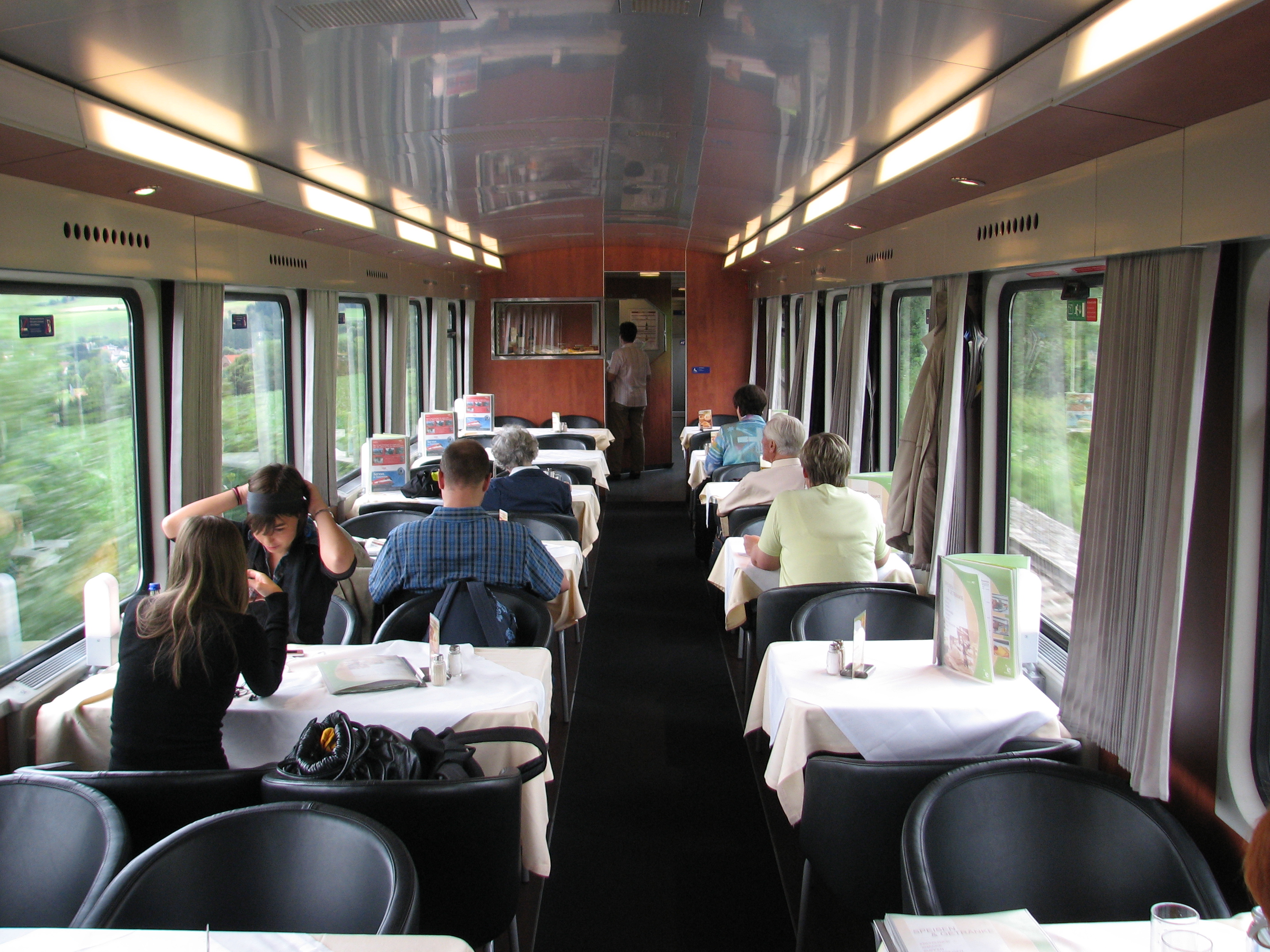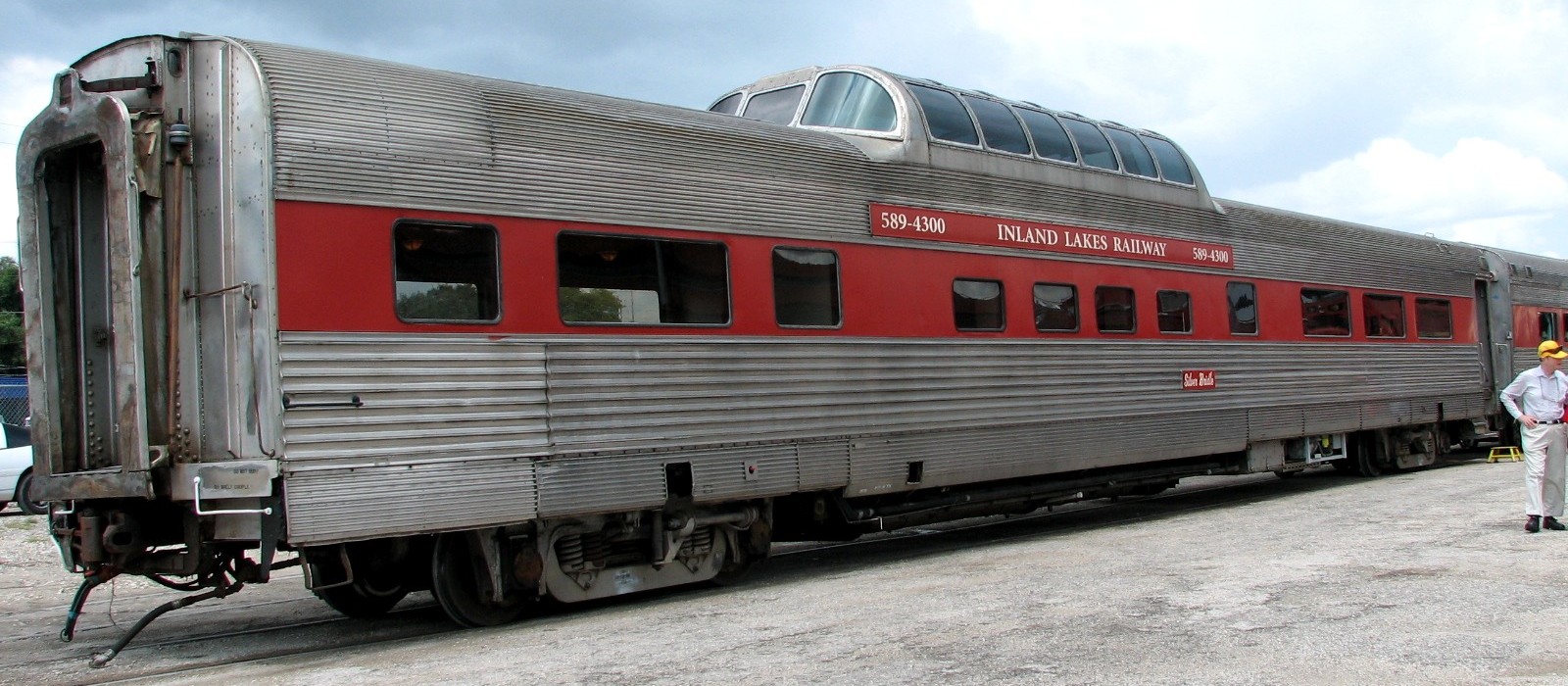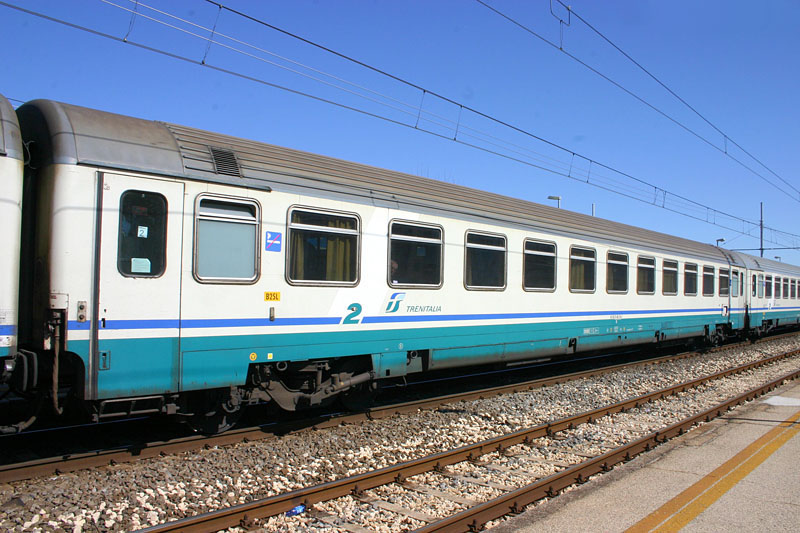|
City Of Portland (train)
The ''City of Portland'' was a named passenger train on the Union Pacific Railroad between Chicago, Illinois, and Portland, Oregon. The first trip left Portland on June 6, 1935, using the streamlined M-10001 trainset. With only one set of equipment, the train left each terminal six times a month. A broken axle derailed the trip that left Chicago on July 23, 1935, and the repaired train resumed service with the trip leaving Portland on February 6, 1936. In May 1936 it started running five times a month instead of six, allowing more time in Chicago between trips. It was the first streamliner with sleeping cars and the first streamliner running from Chicago to the Pacific coast; its 39-hour-45-minute schedule became the standard. (In April 1935 the fastest train took 59 hr 20 min Chicago to Portland.) The M-10001 was withdrawn in March 1938 and replaced with another articulated trainset, the former ''City of Los Angeles'' M-10002. In July 1941 M-10002 was replaced with a train po ... [...More Info...] [...Related Items...] OR: [Wikipedia] [Google] [Baidu] |
Drumhead (sign)
The term drumhead refers to a type of removable sign that was prevalent on North American railroads of the first half of the 20th century. The sign was mounted at the rear of named passenger trains, and consisted of a box with internal illumination that shone through a tinted panel bearing the logo of the railroad or specific train. Since the box and the sign were usually circular in shape and resembled small drums, they came to be known as drumheads. Railroad drumheads were removable so that they could be mounted on different passenger cars (usually on the rear of observations), as needed for specific trains. File:Nebraska Zephyr observation end.jpg, The observation car on the ''Nebraska Zephyr'' at the Illinois Railway Museum in Union, Illinois, showing a rectangular drumhead. File:Blue Comet observation.jpg, The Blue Comet observation car showing a circular drumhead. File:Gold Coast Limited drumhead.JPG, A closeup of a drumhead used on the ''Gold Coast Limited'' of the Chica ... [...More Info...] [...Related Items...] OR: [Wikipedia] [Google] [Baidu] |
EMC E3
The EMC E3 is a , A1A-A1A passenger train locomotive that was manufactured by Electro-Motive Corporation of La Grange, Illinois. The EMC demonstrator #822 was released from La Grange for test on September 12, 1938. The cab version, or E3A, was manufactured from September 1938 to June 1940, and 17 were produced. The booster version, or E3B, was manufactured in March 1939 and September 1939, and 2 were produced. The was achieved by putting two , 12-cylinder, model 567 engines in the engine compartment. Each engine drove its own electrical generator to power the traction motors. The E3 was the fourth model in a long line of passenger diesels of similar design known as EMD E-units. Compared with passenger locomotives made later by EMD, the noses of the E3, E4, E5, and E6 cab units had pronounced slants when viewed from the side. Therefore, these four models have been nicknamed "slant nose" units. Later E models had the more vertical "bulldog nose" of the F series. E3 demonstra ... [...More Info...] [...Related Items...] OR: [Wikipedia] [Google] [Baidu] |
Cedar Rapids Union Station
The Cedar Rapids Union Station served different railroads' passenger operations for six decades. The structure at 4th Street and 4th Avenue SE, Cedar Rapids, was opened with fanfare in 1897 with a gala for Cedar Rapids' charities. The station was 600 feet long with gargoyles. The interior of the main building was 40 by 400 feet and 27 feet high. The station served the Chicago and North Western Railroad and the Rock Island Railroad, as such, it was a hub for trains from Minneapolis, Chicago, Omaha, St. Louis, Kansas City, Denver, Portland and the Oakland/San Francisco market. Additionally, Railway Post Office rail cars were handled at the station. Cedar Rapids was accompanied by another railroad station, the Milwaukee Depot on 1st Avenue SE, serving trains of the Milwaukee Road and the Illinois Central. In its later years service declined. In 1955, the Union Pacific Railroad changed its partner for the eastern leg of West Coast – Chicago trips from Chicago and North Western to ... [...More Info...] [...Related Items...] OR: [Wikipedia] [Google] [Baidu] |
Chicago Union Station
Chicago Union Station is an intercity and commuter rail terminal located in the Near West Side neighborhood of Chicago, Illinois. The station is Amtrak's flagship station in the Midwest. While serving long-distance passenger trains, it is also the downtown terminus for six Metra commuter lines. The station is just west of the Chicago River between West Adams Street and West Jackson Boulevard, adjacent to the Chicago Loop. Including approach and storage tracks, it covers about nine and a half city blocks (mostly underground, buried beneath streets and skyscrapers). The present Chicago Union Station opened in 1925, replacing an earlier station on this site built in 1881. The station is the fourth-busiest rail station in the United States, after Pennsylvania Station, Grand Central Terminal, and Jamaica station in New York City. It is Amtrak's overall fourth-busiest station, and 120,000 daily Metra riders and the busiest outside of its Northeast Corridor. It handles about 140, ... [...More Info...] [...Related Items...] OR: [Wikipedia] [Google] [Baidu] |
Dining Car
A dining car (American English) or a restaurant car (British English), also a diner, is a railroad passenger car that serves meals in the manner of a full-service, sit-down restaurant. It is distinct from other railroad food service cars that do not duplicate the full-service restaurant experience, such as buffet cars, cars in which one purchases food from a walk-up counter to be consumed either within the car or elsewhere in the train. Grill cars, in which customers sit on stools at a counter and purchase and consume food cooked on a grill behind the counter are generally considered to be an "intermediate" type of dining car. History United States Before dining cars in passenger trains were common in the United States, a rail passenger's option for meal service in transit was to patronize one of the roadhouses often located near the railroad's "water stops". Fare typically consisted of rancid meat, cold beans, and old coffee. Such poor conditions discouraged many from makin ... [...More Info...] [...Related Items...] OR: [Wikipedia] [Google] [Baidu] |
Observation Car
An observation car/carriage/coach (in US English, often abbreviated to simply observation or obs) is a type of railroad passenger car, generally operated in a passenger train as the rearmost carriage, with windows or a platform on the rear of the car for passengers' viewing pleasure. The cars were nearly universally removed from service on American railroads beginning in the 1950s as a cost-cutting measure in order to eliminate the need to "turn" the trains when operating out of stub-end terminals. The push-pull mode of operation removes this limitation. In Europe, various trains are now fitted with observation cars at either or both ends. Configuration The main spotting feature of observation cars is at the "B" end (tail) of the car; the walls of lightweight and streamlined cars usually round together to form a tapered U shape, smoothly or with a door, and larger panoramic windows were installed all around the end of the car. On older heavyweight cars, the rear end of the car ... [...More Info...] [...Related Items...] OR: [Wikipedia] [Google] [Baidu] |
Dome Car
A dome car is a type of railway passenger car that has a glass dome on the top of the car where passengers can ride and see in all directions around the train. It also can include features of a coach, lounge car, dining car, sleeping car or observation. Beginning in 1945, dome cars were primarily used in the United States and Canada, though a small number were constructed in Europe for Trans Europ Express service, and similar panorama cars are in service on Alpine tourist railways like the Bernina Express. In North America, dome cars were manufactured by the Budd Company, Pullman Standard and American Car & Foundry. Southern Pacific Railroad built its own dome cars in its Sacramento, California, shops. In the 1990s Colorado Railcar began producing dome cars. Generally, seats in the dome were considered "non-revenue" like lounge car seats. Configuration A portion of the car, usually in the center of the car but offset towards one end, is split between two levels. The offset resu ... [...More Info...] [...Related Items...] OR: [Wikipedia] [Google] [Baidu] |
Astra Dome
The Astra Domes were a fleet of streamlined dome cars built by the American Car and Foundry Company ("ACF") and later by Pullman-Standard ("PS") for the Union Pacific Railroad between 1954–1958. ACF built a total of 35 cars including coaches, dining cars, and observation cars, while PS built 5 for Union Pacific. After Union Pacific exited the passenger business in 1971 the Auto-Train Corporation purchased most of the fleet and operated them for an additional ten years. Design ACF produced three types of domes for the Union Pacific: coaches, dining cars, and observation cars. The ten dining cars were unique: the only dome dining cars (aside from GM's ''Train of Tomorrow'') ever built for a United States railroad. The cars featured seating on both levels: 18 in the upper level in booths and 18 in the lower level at tables. Also located on the lower level was a kitchen, pantry, and private dining room with seating for 10. A dumbwaiter connected the two levels. The coaches coul ... [...More Info...] [...Related Items...] OR: [Wikipedia] [Google] [Baidu] |
Sleeping Car
The sleeping car or sleeper (often ) is a railway passenger car (rail), passenger car that can accommodate all passengers in beds of one kind or another, for the purpose of sleeping. George Pullman was the American innovator of the sleeper car. The first such cars saw sporadic use on American and English railways in the 1830s; they could be configured for Coach (rail), coach seating during the day. History Possibly the earliest example of a sleeping car (or ''bed carriage'', as it was then called) was on the London & Birmingham and Grand Junction Railways between London and Lancashire, England. The bed carriage was first made available to first-class passengers in 1838. In the spring of 1839, the Cumberland Valley Railroad pioneered sleeping car service in America with a car named "Chambersburg", between Chambersburg, Pennsylvania, Chambersburg and Harrisburg, Pennsylvania. A couple of years later a second car, the "Carlisle", was introduced into service. [...More Info...] [...Related Items...] OR: [Wikipedia] [Google] [Baidu] |
Coach (rail)
A passenger railroad car or passenger car (United States), also called a passenger carriage, passenger coach (United Kingdom and International Union of Railways), or passenger bogie (India) is a railroad car that is designed to carry passengers. The term ''passenger car'' can also be associated with a sleeping car, a baggage car, a dining car, railway post office and prisoner transport cars. The first passenger cars were built in the early 1800s with the advent of the first railroads, and were small and little more than converted freight cars. Early passenger cars were constructed from wood; in the 1900s construction shifted to steel and later aluminum for improved strength. Passenger cars have increased greatly in size from their earliest versions, with modern bi-level passenger cars capable of carrying over 100 passengers. Amenities for passengers have also improved over time, with developments such as lighting, heating, and air conditioning added for improved passenge ... [...More Info...] [...Related Items...] OR: [Wikipedia] [Google] [Baidu] |
Baggage Car
A passenger railroad car or passenger car (United States), also called a passenger carriage, passenger coach (United Kingdom and International Union of Railways), or passenger bogie (India) is a railroad car that is designed to carry passengers. The term ''passenger car'' can also be associated with a sleeping car, a baggage car, a dining car, railway post office and prisoner transport cars. The first passenger cars were built in the early 1800s with the advent of the first railroads, and were small and little more than converted freight cars. Early passenger cars were constructed from wood; in the 1900s construction shifted to steel and later aluminum for improved strength. Passenger cars have increased greatly in size from their earliest versions, with modern bi-level passenger cars capable of carrying over 100 passengers. Amenities for passengers have also improved over time, with developments such as lighting, heating, and air conditioning added for improved passenge ... [...More Info...] [...Related Items...] OR: [Wikipedia] [Google] [Baidu] |
Ogden, Utah
Ogden is a city in and the county seat of Weber County, Utah, United States, approximately east of the Great Salt Lake and north of Salt Lake City. The population was 87,321 in 2020, according to the US Census Bureau, making it Utah's eighth largest city. The city served as a major railway hub through much of its history,Maia Armaleo "Grand Junction: Where Two Lines Raced to Drive the Last Spike in Transcontinental Track," ''American Heritage'', June/July 2006. and still handles a great deal of freight rail traffic which makes it a convenient location for and |





